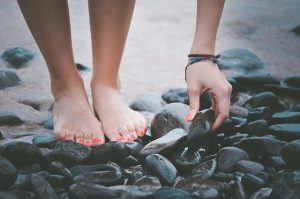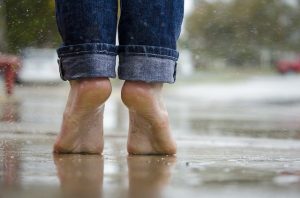I don’t know about you, but during this Covid 19 pandemic, one of the few things that have kept me sane is walking. We live near a bike and walking path that follows a small creek, crosses over a number of marshes, and circles a small open park. I manage to get out and walk a couple of times a day. Full disclosure: I’m not that motivated; we have a dog who needs some serious walking.
 So, while I’m hunkered down at home, I only need a couple of things to stay in shape—a good pair of walking shoes and healthy feet. I say healthy feet, because foot pain is no joke. It can change your life, and not for the better. A bunion, sprained ankle, or neuroma can affect your ability to walk, exercise, travel, and even work.
So, while I’m hunkered down at home, I only need a couple of things to stay in shape—a good pair of walking shoes and healthy feet. I say healthy feet, because foot pain is no joke. It can change your life, and not for the better. A bunion, sprained ankle, or neuroma can affect your ability to walk, exercise, travel, and even work.
Over the years, some of the most common foot issues I have treated include:
- Bunions, which are a painful and unattractive misalignment of the first joint of your big toe, or in rare instances, your smallest toe. A bunion makes your toe point inward toward the other toes instead of pointing straight forward.
- Plantar fasciitis, which is an inflammation on the tendon and fascia on the bottom of your foot. Plantar fasciitis is often associated with poor arch support, fallen arches, and stress on your feet due to overuse or weight gain.
- A neuroma occurs when the nerve between your metatarsal bones (the ones in the front of your foot, behind your toes) trap and compress the nerve, causing pain and frequently the sensation that you have a large pebble in your shoe.
- Achilles tendonitis is inflammation of the thick tendon that runs between the back of your heel and your calf. It can occur from overuse, injury, or shortening of the tendon from wearing high heels or poor flexibility.
- A sprained ankle can be one of the most painful injuries to your foot. When your ankle is rolled or twisted beyond its capacity, the ligaments that connect bone to bone become injured, causing swelling, pain, and future instability.
With any of these injuries, acupuncture can help relieve pain and decrease inflammation in the area. While it can’t change a structural issue, as in the case of bunions, acupuncture can help speed up the healing process after an ankle sprain, foot surgery, or a sports injury. Besides acupuncture, your practitioner may also employ other healing methods, such as electro acupuncture, massage therapy, heat therapy, or microcurrent—a mild electrical current that stimulates healing in the area.
In addition to acupuncture, there are things that you can do for yourself to help prevent pain and keep your feet as healthy as possible, especially if you’re prone to foot pain. Among them:
-Ditch your high heels. If I had to limit my recommendations to only one, it would be this. Feet that have been crammed into narrow-toed high heels are far more likely to develop bunions than those that have been wearing flats or sneakers. Furthermore, once your feet have been stuffed into high heels, your weight is pushed forward onto your toes, making you more prone to neuromas, shortening your Achilles tendon, and making you more unstable in general.
-If I were asked about my second most important recommendation, it would be to get rid of cheap flip flops. While they’re easy and comfortable in the warm weather, flip flops don’t support the arches in your feet, and can be the cause of knee pain, plantar fasciitis, and straight up achy feet. If you can’t part with wearing flip flops, it’s good to know that some companies make healthy flip flops with good arch support.
-Choose the right shoes for the job. If your exercise regimen includes running or walking, make sure you have the right shoes. The best way to do this is to buy them at a reputable athletic shoe store. There, someone can help you find shoes to accommodate whether your foot rolls inward or outward when you walk or run, and whether you need a straight or curved-lasted shoe, depending on the shape of your arch.
-If you have a neuroma, buy shoes with a very wide toe box. You may have to buy a size larger or wider, but it will be worth it. Narrow shoes can cause or aggravate a neuroma.
-Update your shoes regularly. As your shoes wear out, they offer less support and can increase your risk for developing pain or injury. In addition, when you get new shoes, go easy at first. Whether you’re wearing new flats or running shoes, break them in over short periods of time before you put them on for the whole day or that really long run.
when you get new shoes, go easy at first. Whether you’re wearing new flats or running shoes, break them in over short periods of time before you put them on for the whole day or that really long run.
-Massage your feet. Use a little moisturizing lotion and go to work on those aches and pains. Massage to help stretch your feet and work out the tight, achy spots. You could also find a partner who’s willing to massage your feet for you (or trade foot massages) or a compression massager (highly recommended, I have a Theragun mini and it has saved my life).
-Stretch your Achilles tendon to loosen up your calf muscles. Doing so will not only make you less prone to Achilles tendonitis, but in many cases, shortened Achilles tendons are the culprit in plantar fasciitis.
-After a long day on your feet, give them a soak. Alternate between five minutes of cold water and five minutes of hot water, then repeat. By doing so, you are opening and closing the blood vessels in your feet, increasing the circulation and reducing swelling.
The bottom line is that you may not think about keeping your feet healthy until they start to bother you. And it’s a lot harder to recover from a foot problem than it is to prevent it in the first place. So give your feet al little love. They’ll reward you over many miles.



